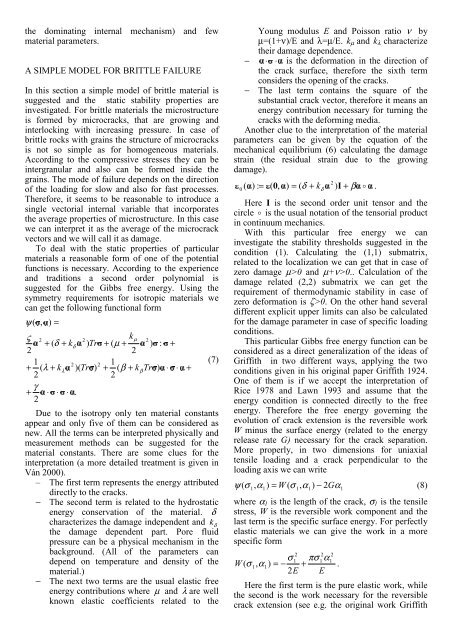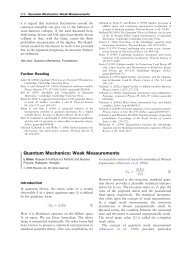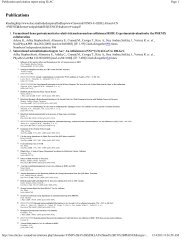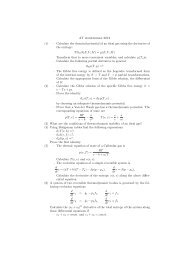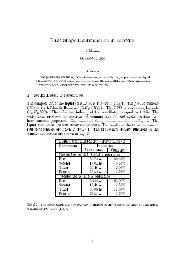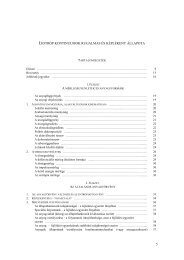Second Law of thermodynamics and the failure of rock materials
Second Law of thermodynamics and the failure of rock materials
Second Law of thermodynamics and the failure of rock materials
Create successful ePaper yourself
Turn your PDF publications into a flip-book with our unique Google optimized e-Paper software.
<strong>the</strong> dominating internal mechanism) <strong>and</strong> few<br />
material parameters.<br />
A SIMPLE MODEL FOR BRITTLE FAILURE<br />
In this section a simple model <strong>of</strong> brittle material is<br />
suggested <strong>and</strong> <strong>the</strong> static stability properties are<br />
investigated. For brittle <strong>materials</strong> <strong>the</strong> microstructure<br />
is formed by microcracks, that are growing <strong>and</strong><br />
interlocking with increasing pressure. In case <strong>of</strong><br />
brittle <strong>rock</strong>s with grains <strong>the</strong> structure <strong>of</strong> microcracks<br />
is not so simple as for homogeneous <strong>materials</strong>.<br />
According to <strong>the</strong> compressive stresses <strong>the</strong>y can be<br />
intergranular <strong>and</strong> also can be formed inside <strong>the</strong><br />
grains. The mode <strong>of</strong> <strong>failure</strong> depends on <strong>the</strong> direction<br />
<strong>of</strong> <strong>the</strong> loading for slow <strong>and</strong> also for fast processes.<br />
Therefore, it seems to be reasonable to introduce a<br />
single vectorial internal variable that incorporates<br />
<strong>the</strong> average properties <strong>of</strong> microstructure. In this case<br />
we can interpret it as <strong>the</strong> average <strong>of</strong> <strong>the</strong> microcrack<br />
vectors <strong>and</strong> we will call it as damage.<br />
To deal with <strong>the</strong> static properties <strong>of</strong> particular<br />
<strong>materials</strong> a reasonable form <strong>of</strong> one <strong>of</strong> <strong>the</strong> potential<br />
functions is necessary. According to <strong>the</strong> experience<br />
<strong>and</strong> traditions a second order polynomial is<br />
suggested for <strong>the</strong> Gibbs free energy. Using <strong>the</strong><br />
symmetry requirements for isotropic <strong>materials</strong> we<br />
can get <strong>the</strong> following functional form<br />
ψ (<br />
,<br />
) =<br />
ς 2<br />
2<br />
+ ( δ + kδ<br />
) Tr<br />
2<br />
1<br />
2<br />
+ ( λ + kλ<br />
)( Tr )<br />
2<br />
γ<br />
+ ⋅ ⋅ ⋅ .<br />
2<br />
2<br />
kµ<br />
2<br />
+ ( µ + )<br />
2<br />
1<br />
+ ( β + kβTr<br />
2<br />
)<br />
:<br />
⋅<br />
+<br />
⋅<br />
+<br />
(7)<br />
Due to <strong>the</strong> isotropy only ten material constants<br />
appear <strong>and</strong> only five <strong>of</strong> <strong>the</strong>m can be considered as<br />
new. All <strong>the</strong> terms can be interpreted physically <strong>and</strong><br />
measurement methods can be suggested for <strong>the</strong><br />
material constants. There are some clues for <strong>the</strong><br />
interpretation (a more detailed treatment is given in<br />
Ván 2000).<br />
– The first term represents <strong>the</strong> energy attributed<br />
directly to <strong>the</strong> cracks.<br />
− The second term is related to <strong>the</strong> hydrostatic<br />
energy conservation <strong>of</strong> <strong>the</strong> material. δ<br />
characterizes <strong>the</strong> damage independent <strong>and</strong> kδ<br />
<strong>the</strong> damage dependent part. Pore fluid<br />
pressure can be a physical mechanism in <strong>the</strong><br />
background. (All <strong>of</strong> <strong>the</strong> parameters can<br />
depend on temperature <strong>and</strong> density <strong>of</strong> <strong>the</strong><br />
material.)<br />
− The next two terms are <strong>the</strong> usual elastic free<br />
energy contributions where µ <strong>and</strong> λ are well<br />
known elastic coefficients related to <strong>the</strong><br />
Young modulus E <strong>and</strong> Poisson ratio ν by<br />
µ=(1+ν)/E <strong>and</strong> λ=µ/E. k µ <strong>and</strong> k λ characterize<br />
<strong>the</strong>ir damage dependence.<br />
− ⋅ ⋅ is <strong>the</strong> deformation in <strong>the</strong> direction <strong>of</strong><br />
<strong>the</strong> crack surface, <strong>the</strong>refore <strong>the</strong> sixth term<br />
considers <strong>the</strong> opening <strong>of</strong> <strong>the</strong> cracks.<br />
− The last term contains <strong>the</strong> square <strong>of</strong> <strong>the</strong><br />
substantial crack vector, <strong>the</strong>refore it means an<br />
energy contribution necessary for turning <strong>the</strong><br />
cracks with <strong>the</strong> deforming media.<br />
Ano<strong>the</strong>r clue to <strong>the</strong> interpretation <strong>of</strong> <strong>the</strong> material<br />
parameters can be given by <strong>the</strong> equation <strong>of</strong> <strong>the</strong><br />
mechanical equilibrium (6) calculating <strong>the</strong> damage<br />
strain (<strong>the</strong> residual strain due to <strong>the</strong> growing<br />
damage).<br />
2<br />
0<br />
( ) : = ( 0,<br />
) = ( δ + k<br />
δ<br />
) I + β o .<br />
Here I is <strong>the</strong> second order unit tensor <strong>and</strong> <strong>the</strong><br />
circle o is <strong>the</strong> usual notation <strong>of</strong> <strong>the</strong> tensorial product<br />
in continuum mechanics.<br />
With this particular free energy we can<br />
investigate <strong>the</strong> stability thresholds suggested in <strong>the</strong><br />
condition (1). Calculating <strong>the</strong> (1,1) submatrix,<br />
related to <strong>the</strong> localization we can get that in case <strong>of</strong><br />
zero damage µ>0 <strong>and</strong> µ+ν>0.. Calculation <strong>of</strong> <strong>the</strong><br />
damage related (2,2) submatrix we can get <strong>the</strong><br />
requirement <strong>of</strong> <strong>the</strong>rmodynamic stability in case <strong>of</strong><br />
zero deformation is ζ>0. On <strong>the</strong> o<strong>the</strong>r h<strong>and</strong> several<br />
different explicit upper limits can also be calculated<br />
for <strong>the</strong> damage parameter in case <strong>of</strong> specific loading<br />
conditions.<br />
This particular Gibbs free energy function can be<br />
considered as a direct generalization <strong>of</strong> <strong>the</strong> ideas <strong>of</strong><br />
Griffith in two different ways, applying <strong>the</strong> two<br />
conditions given in his original paper Griffith 1924.<br />
One <strong>of</strong> <strong>the</strong>m is if we accept <strong>the</strong> interpretation <strong>of</strong><br />
Rice 1978 <strong>and</strong> <strong>Law</strong>n 1993 <strong>and</strong> assume that <strong>the</strong><br />
energy condition is connected directly to <strong>the</strong> free<br />
energy. Therefore <strong>the</strong> free energy governing <strong>the</strong><br />
evolution <strong>of</strong> crack extension is <strong>the</strong> reversible work<br />
W minus <strong>the</strong> surface energy (related to <strong>the</strong> energy<br />
release rate G) necessary for <strong>the</strong> crack separation.<br />
More properly, in two dimensions for uniaxial<br />
tensile loading <strong>and</strong> a crack perpendicular to <strong>the</strong><br />
loading axis we can write<br />
ψ ( σ = Gα<br />
(8)<br />
1,<br />
α1)<br />
W ( σ<br />
1,<br />
α1)<br />
− 2<br />
where α 1 is <strong>the</strong> length <strong>of</strong> <strong>the</strong> crack, σ 1 is <strong>the</strong> tensile<br />
stress, W is <strong>the</strong> reversible work component <strong>and</strong> <strong>the</strong><br />
last term is <strong>the</strong> specific surface energy. For perfectly<br />
elastic <strong>materials</strong> we can give <strong>the</strong> work in a more<br />
specific form<br />
2 2 2<br />
σ<br />
1<br />
πσ<br />
1α1<br />
W ( σ<br />
1,<br />
α1)<br />
= − + .<br />
2E<br />
E<br />
Here <strong>the</strong> first term is <strong>the</strong> pure elastic work, while<br />
<strong>the</strong> second is <strong>the</strong> work necessary for <strong>the</strong> reversible<br />
crack extension (see e.g. <strong>the</strong> original work Griffith<br />
1


